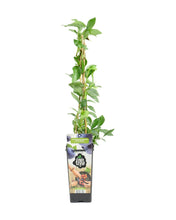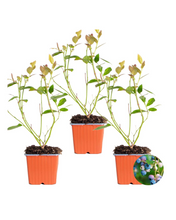Vaccinium corymbosum is the blueberry plant, there are many cultivars, we have 'Goldtraube', also known as the Goldtraube blueberry, is a popular and productive blueberry cultivar prized for its abundant crops of sweet, yellow blueberries. There is also 'Bluecrop' which produces clusters of small, white flowers in spring followed by heavy crops of large, blue, firm fruits with a rich flavour in early-mid summer.
This deciduous shrub features attractive foliage that turns a vibrant red in autumn, and it produces clusters of small, bell-shaped, white or pink flowers in spring, followed by a profusion of golden-yellow berries in mid-summer. It's a fantastic choice for gardens, allotments, and containers, providing both visual interest and delicious, healthy fruit. It belongs to the Ericaceae family.
Origin: Vaccinium corymbosum 'Goldtraube' is a German variety, believed to have been developed in the late 20th century.
Light: Vaccinium corymbosum thrives in full sun to partial shade. It prefers at least 6 hours of sunlight per day to encourage optimal growth and fruit production, but in hotter climates, it may benefit from some afternoon shade.
Water: Water regularly, especially during dry periods and the first year after planting. Blueberries prefer consistently moist, well-drained soil. Avoid overwatering, which can lead to root rot.
Soil: Vaccinium corymbosum requires acidic soil with a pH between 4.5 and 5.5. It thrives in loose, well-draining soil that is rich in organic matter. You can amend the soil with ericaceous compost or peat moss to increase acidity and improve drainage.
Fertilising: Feed your Vaccinium corymbosum with a fertiliser specifically formulated for ericaceous plants. Apply the fertiliser in spring and early summer, following the instructions on the product label. Avoid over-fertilising.
Pollination: While Vaccinium corymbosum is self-fertile, planting another blueberry variety nearby can improve fruit set and yield.
Pruning: Prune your Vaccinium corymbosum in winter while it is dormant to remove any dead or diseased wood and to maintain shape. You can also thin out overcrowded branches to improve air circulation.
Harvesting: The blueberries typically ripen in mid-summer. Harvest the berries when they are fully ripe and a golden-yellow colour.
Pests and Diseases: Keep an eye out for common blueberry pests and diseases, such as birds, aphids, and powdery mildew.
Uses: The berries are delicious eaten fresh or can be used in jams, pies, and other culinary creations. Blueberries are also packed with antioxidants and nutrients.
Toxicity: Vaccinium corymbosum is not known to be toxic to humans or pets.



